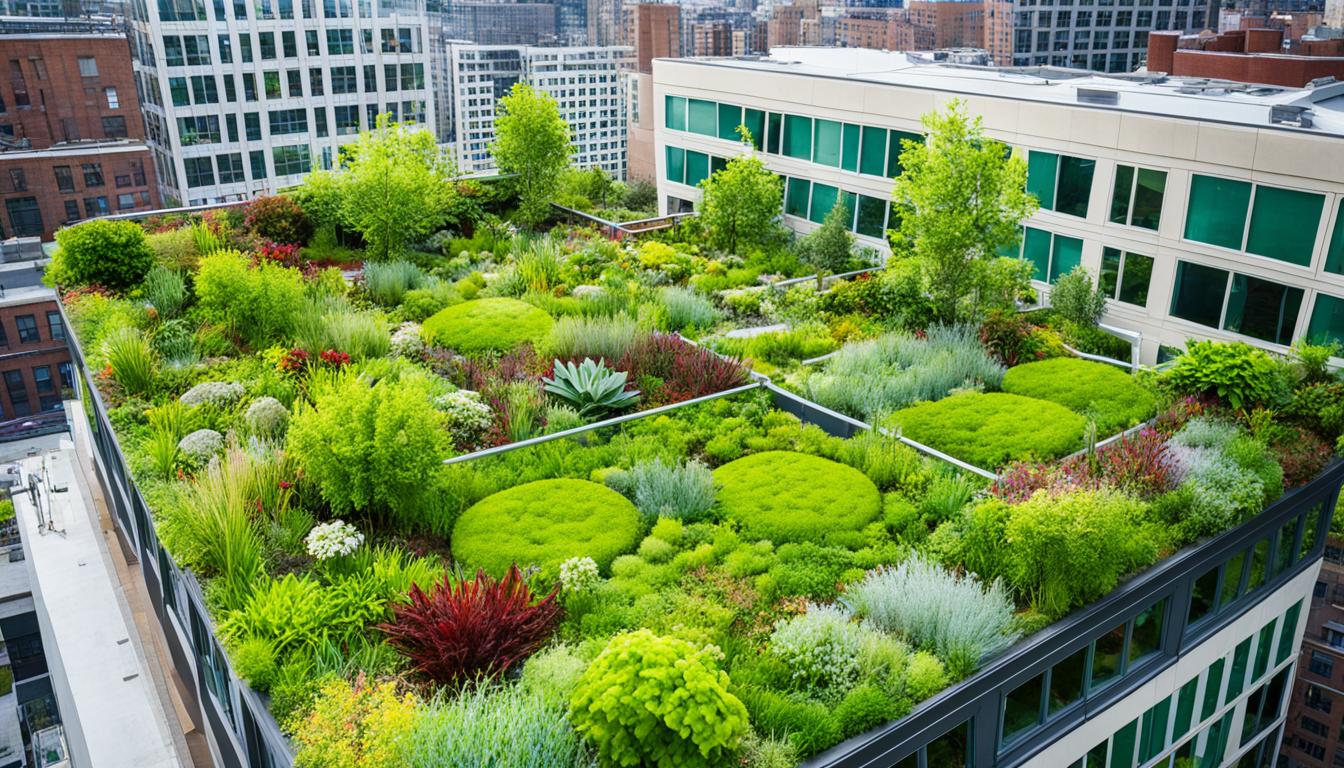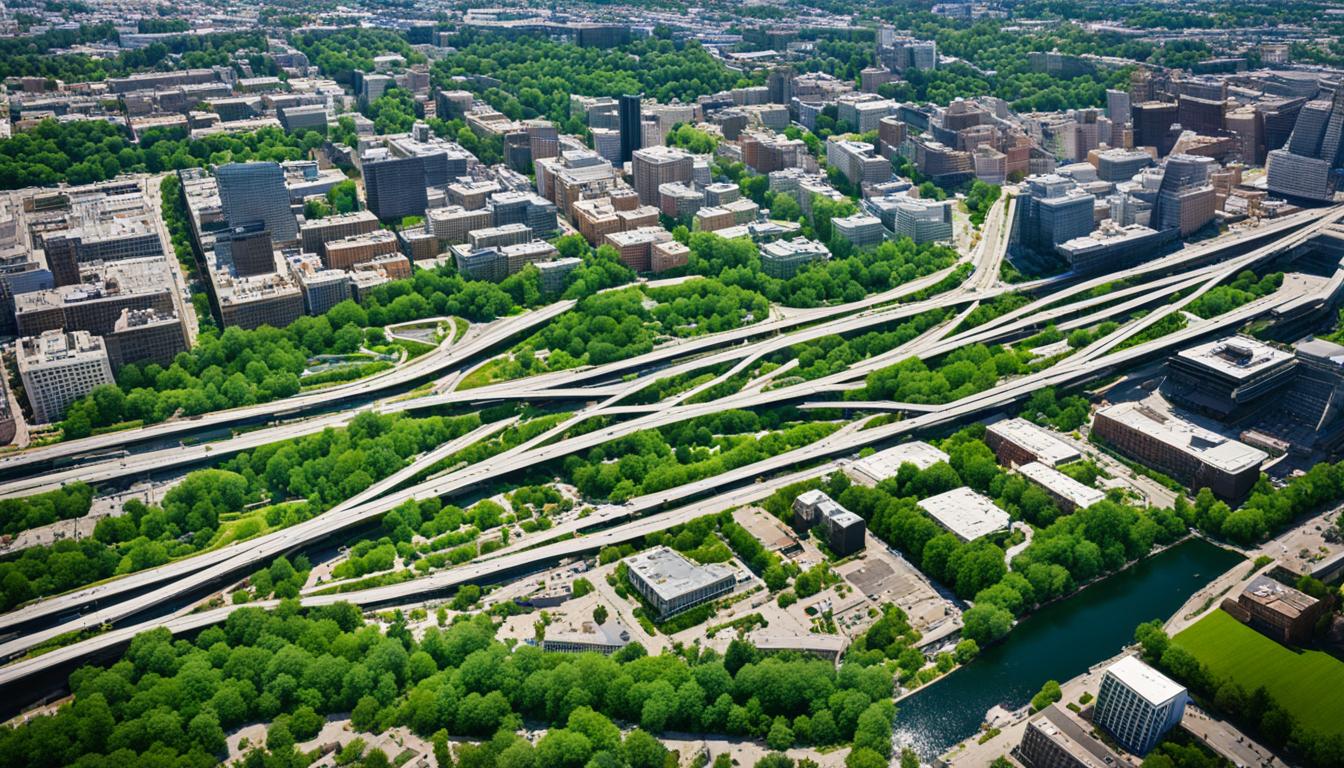Biophilic Design: Enhancing Biodiversity Through Architecture
Did you know that biophilic design can help up to 15% of the world’s threatened species? This shows how powerful biophilic design, green architecture, and sustainable construction are. They make a big difference in enhancing biodiversity and bringing back natural spaces in our cities.
Biophilic design is based on our deep connection to nature. It brings nature-inspired elements like plants, natural light, and water features into buildings. By doing this, these places boost well-being and reduce stress for people living or working there. They also help with ecological urban planning, habitat restoration, and making wildlife corridors. This new way of designing shows how we can learn from nature to make better places for everyone.
This way of designing can change our cities for the better. The future of where we live and work could be much healthier. They will be beautiful places that live well with nature. Architects and urban planners can lead the way in creating a future where we respect the Earth and help protect many species.
Key Takeaways
- Biophilic design integrates nature into architectural design to enhance biodiversity and well-being.
- Biophilic buildings promote stress reduction, improved cognitive function, creativity, and overall health and well-being.
- Biophilic design aligns with sustainable practices and contributes to a more environmentally friendly future.
- The future of biophilic design holds promise for healthier, more sustainable, and aesthetically pleasing built environments.
- Biophilic design can support up to 15% of the world’s threatened species through habitat restoration and wildlife corridors.
The Power of Biophilic Design
Biophilic design brings nature into architecture, adding greenery, light, and water. It aims to boost biodiversity and enhance our well-being. With nature elements like plants, buildings make us feel part of the natural world.
Integrating Nature into Architectural Design
Designers now see how biophilic design can join our man-made surroundings with nature. They mix sustainable buildings with greenery and water. This creates a strong bond between people and the environment around them.
Reconnecting with the Natural World
Studies show that being in nature-rich buildings lower stress and increase brainpower. They also boost creativity and give us a general sense of well-being. Biophilic design reconnects us with nature, making our daily experience better.
Benefits of Biophilic Buildings
The benefits of biophilic design go beyond our health. It also helps the planet by being eco-friendly. These buildings support life on Earth and cut down on the harm to our planet.
Understanding Biophilic Design’s Contribution to Sustainability
Biophilic design changes how we see buildings by bringing nature inside. It combines structures with natural elements. This mix helps people feel better and the planet hurt less. It aims to make our living spaces healthier and kinder to nature around us.
Improve Well-being and Connection to Nature
This design boosts our happiness by having nature all around us. Inside, you might find plants, sunlight, or a view of the outdoors. These things make us feel good and help us connect with the Earth. Being around nature can lower stress, help you think better, and just feel more at ease. It’s a win for our bodies and minds.
Contributing to Biodiversity and Ecosystem Services
Adding green bits to our buildings can help local wildlife find homes. This means more animals and insects can live there. It also helps with things like keeping water clean and helping plants grow. So, buildings that welcome nature back can make our cities greener and healthier for everyone.
Circularity and Sustainable Material Choices
This design theme also picks materials that don’t hurt the planet. It chooses things that can be used again and again. This helps us use less new stuff and make less waste. It’s all about keeping things going for the long term. Choosing these kinds of materials is good for the Earth and for future building ideas.

Biophilic Design Patterns
Biophilic design says we’re naturally linked to nature. So, architects use design to bring nature indoors. They aim to boost our health and feelings by doing this.
This design type makes sure we see nature in our surroundings. It blends natural things like plants and water into buildings. It also welcomes outdoor views inside. By adding nature’s sounds and scents, it keeps all our senses happy.
Biophilic design also offers sights like moving tree leaves and changing lights. These calm us and hold our interest. Making indoor temperatures and air flows natural can help, too.
Water features add a lot to this design, whether it’s a small fountain or a big reflecting pool. Playful light patterns also mimic the changing sun, making places feel soothingly real.
This design way makes buildings work like natural habitats. It includes shapes from nature, making structures feel linked with the earth.
Putting these design elements together helps create better spaces. These spaces help us feel more connected to nature and boost our happiness.

Biophilic Architecture in History
Biophilic architecture is about bringing nature’s touch into how we design buildings. It’s not a new idea. Humans have always looked to the natural world for design ideas. For example, look at the Egyptian sphinx and Greek temples. They were decorated with plants and leaf patterns. This shows ancient people knew nature should be a big part of their designs.
Proven Benefits of Biophilic Design
Studies show that having natural elements in our buildings can make us feel better. It helps us relax, think better, and feel happier. The benefits of biophilic design are clear. They show adding trees, plants, and natural light can really improve our lives.
The Influence of Biophilic Architecture Today
Today, biophilic architecture is still very important. Architects and city planners make spaces that help us feel closer to nature. They use what we learned from ancient times. And they know how nature can help us live better. This all makes modern buildings feel more natural and humans and nature come closer.

Promoting Biodiversity with Green Roofs and Walls
Green roofs and walls are key in boosting biodiversity through architecture. These features give homes to many plants and animals. They also combat the effects of the urban heat island, help clean the air, and manage water from storms. Adding green spaces to building designs helps nature thrive locally and aids the community too.
These green spaces are great at fighting the urban heat island effect. They keep places cooler and lessen pollution. They also absorb rain, which stops flooding. Life like insects and birds thrives in these areas. Plus, they make our towns and cities greener and better for everyone.
| Benefits of Green Roofs and Walls | Impact on Biodiversity |
|---|---|
| Reduce urban heat island effect | Provide habitat for diverse plant and animal species |
| Improve air quality by absorbing pollutants | Support ecosystem services such as pollination |
| Manage stormwater runoff | Enhance the overall ecological resilience of urban areas |
When architects add green roofs and walls, they do more than just create cool spaces. They also help nature recover and make cities better for living. This step towards sustainable urban design increases the mingling of different life forms.

Using Sustainable Building Materials for Biodiversity Integration
The use of sustainable building materials is key in architecture’s link with biodiversity. These materials help cut down the harm from construction on the environment. Architects can choose materials that are local, renewable, and safe. This choice helps reduce destruction of nature and pollution. It makes our built world more eco-friendly and better for the planet.
By picking materials found nearby, we lower how far they must travel. This reduces the gases causing climate change that come from moving them. Also, using these local materials is good for people and nature. Materials like reclaimed wood, bamboo, recycled steel, and safe paints meet high standards of care for the earth. They bring their own unique beauty and style. Including them in designs helps nature flourish. Plus, it makes building work less hard on the planet.

Enhancing Biodiversity Through Architecture
Making room for plants and animals in our designs is now essential. Architects and designers must work to fix the harm to our world. They need to use ecological design features that help both us and the environment.
Green roofs and walls and using sustainable building materials are key steps. These, along with smart site planning, can boost plant and animal life where we build. Designing with nature, known as biophilic design, also makes people happier. It helps nature and buildings fit well together. It’s important to look after all life, not just humans, in our cities to keep them healthy and diverse.

Designing Buildings as Habitat for Specific Species
Architects can make unique contributions by creating buildings that are homes for specific animals and insects. They add nests for birds and places for bees and butterflies to live. This helps in urban wildlife conservation within our cities.
Adding bird nesting spots helps those birds who are struggling to find places to nest in cities. Building homes for bees and butterflies is vital for our plants, as they help in pollination. Architects work with experts in nature to design the perfect living spaces for these creatures.
Building homes for specific species improves biodiversity and makes our cities more interesting and green. By including nature in designs, architects help create cities where both people and wildlife can flourish together.
| Key Strategies for Designing Species-Specific Habitats | Benefits |
|---|---|
| Incorporating nesting sites for birds | Supports declining bird populations in urban areas, allows birds to thrive |
| Creating habitats for pollinators like bees and butterflies | Enhances ecosystem health by supporting essential pollination services |
| Collaborating with ecologists and biologists | Ensures designs align with the specific needs and behaviours of targeted species |

Conclusion
Biophilic design looks at how to meet sustainability goals by adding nature-inspired elements to buildings. This approach helps improve health, support biodiversity, and make our living designs more circular and resilient. Architects using these ideas can make spaces that are good for people and the planet. They help make a more sustainable and harmonious built environment.
The future of biophilic design is bright. It’s changing how we design our cities, turning them into places full of life. We aim to connect more with nature by including it in our urban areas. Doing this leads to stronger, responsible, and beautiful places for us to live in.
Using biophilic design principles can change our cities for the better. It helps improve nature and human health. By blending natural elements with our structures, we work towards a future that is greener and more enjoyable. This way, our cities can be more sustainable, richer in nature, and uplifting for everyone.
FAQ
What is biophilic design and how does it integrate nature into architectural design?
What are the benefits of biophilic buildings?
How does biophilic design contribute to biodiversity and sustainability?
What are the different biophilic design patterns that can be incorporated into architecture?
How has biophilic architecture evolved throughout history?
What role do green roofs and walls play in promoting biodiversity in architecture?
How can the use of sustainable building materials enhance biodiversity in architecture?
How can architects design buildings to provide habitat for specific species?
Source Links
- https://learn.constructive-voices.com/biophilic-buildings-enhancing-biodiversity-through-architectural-biodesign/
- https://greenplantsforgreenbuildings.org/theintersecetionofbiophilicdesignandsustainablearchitecture/
- https://learn.constructive-voices.com/the-nature-of-architecture-integrating-biodiversity-into-design-philosophy/








